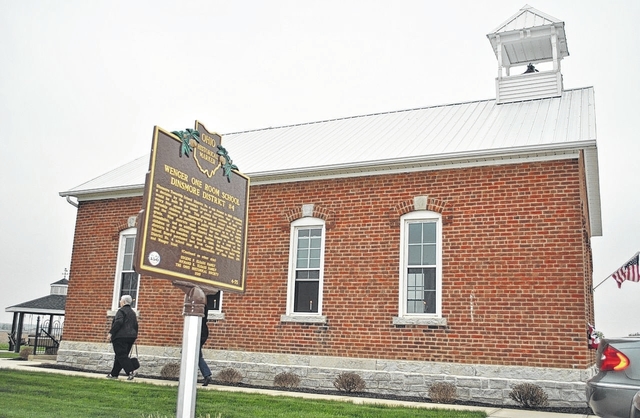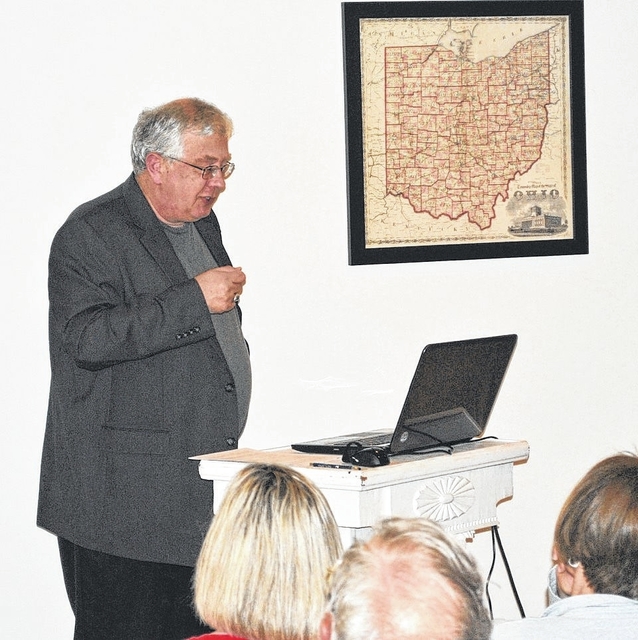

ANNA — Dr. Roy Finkenbine is an Anna native who has made it his life’s work studying the speeches, writings, and activities of black Americans who participated in the vigorous and fervent abolitionist movement in the pre-Civil War era. During his years of research, he kept coming across references to Rumley, Ohio, which for the past century has been but a wide spot on Hardin-Wapakoneta Road in Van Buren Township.
But Dr. Finkenbine found, to his delight, that dot on the map named Rumley, located five-odd miles from where he grew up, had in the mid-nineteenth century a statewide, even national, reputation as an up-and-coming community. Located on a post road between Lima and Piqua in the tabletop lands of western Shelby county, Rumley was a perfect spot for a stagecoach stop and good use was made of the site. In its heyday, Rumley sported a sawmill, a hotel, a livery, schools, a gristmill, and three churches, no doubt to offset the influence of the three saloons that could also be found in the thriving village.
Rumley supported a community of about 500 people, a story made more fascinating by the fact that about five-sixths of those people living in and around Rumley were black.
Dr. Finkenbine was on hand at the lovingly-restored Wenger School on Amsterdam Road on April 26 to give a lecture entitled “Rumley: An African-American Community in Nineteenth-Century Ohio” to members and guests of the Anna District Historical Society. He spent an hour tracing Rumley’s rise and fall in the mid-nineteenth century from its initial founding in 1837 to its virtual disappearance in the 1880’s.
Native Americans were being forced from their lands east of the Mississippi in the 1830s – Ohio included – with the full backing and encouragement of President Jackson, leaving many parts of what was the Old Northwest Territory open for settlement. When lands north of the Greenville Treaty Line made it through the phalanx of land speculators, some of the very first people to jump at the chance make their claims there were free blacks from Maryland, brothers Joel and Wesley Goings*. They and many others found it prudent to make their way north following the draconian measures imposed on all blacks, free or otherwise, by slave-holding states following Nat Turner’s rebellion in 1831.
Rumley was a perfect fit. Fertile, resource-rich and now empty of Native Americans, the Goings, and dozens of other black families, came to Van Buren Township to try and make a go of it.
And made it they did. As noted above, Rumley took off and made a name for itself. It was common for black Americans in the northern states in the antebellum period to conduct regular conventions to exchange ideas on abolition and social policy. Dr. Finkenbine noted Rumley was often mentioned during these conventions as an example of how blacks were quite capable of successfully building strong communities.
But after flourishing through the 1870s, Rumley suffered the same fate of many a small community throughout the United States. Improvements in farm science and machinery pushed out the the subsistence farmers, while the lure of high wages and cultural diversions offered by urban centers proved to be hard to resist and the residents started to drift away. The final nail in the coffin of Rumley’s significance turned out to be a railroad spike, driven by the Chesapeake and Ohio Railroad five miles east of Rumley. After that Rumley slowly withered into what it is today.
Dr. Finkenbine is continuing his research and may yet find more pieces to the puzzle that is the rich history of Rumley and has left the door open to the possibility of returning for another lecture later this year.
*Dr. Finkenbine has come across documents that used both “Goings” and “Goins” as the name of the family that first settled in Rumley. As is it spelled “Goings” on Joel’s headstone, Dr. Finkenbine generally uses that spelling as the correct one.



